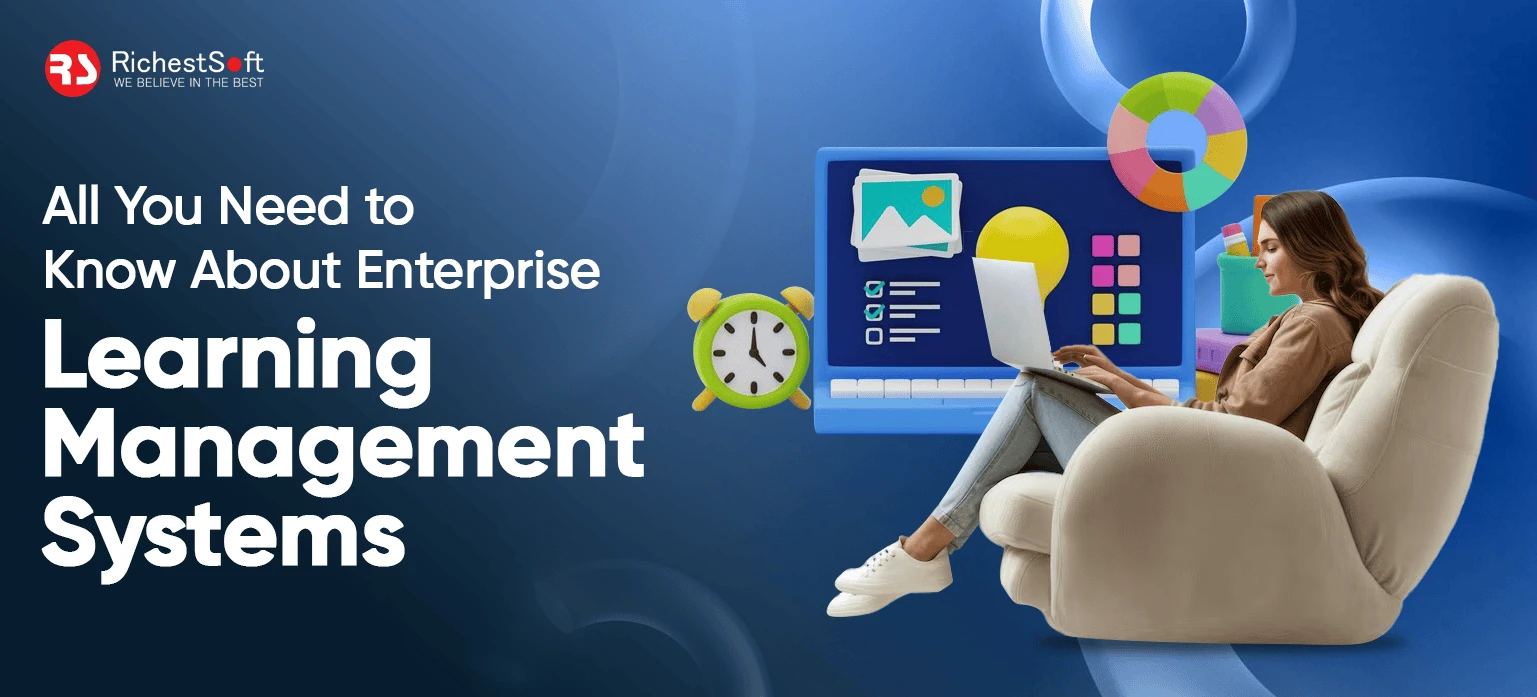April 30, 2025
In a world where digital transformation is changing everything, the way companies train and grow their employees is also evolving fast. Learning is no longer something that happens once a year in a conference room; it happens every day, everywhere. That’s why smart companies are now investing in a powerful solution called the Enterprise Learning Management System (ELMS).
Learning and development are no different. Companies invest in learning ecosystems to onboard employees more efficiently, reskill them, and maintain the team’s productivity. Whether managing a workforce of 200 or 20,000, the right ELMS helps you deliver consistent, engaging, and measurable learning across your organization.
In this article, we will examine what is a learning management system?, its importance for modern enterprises, and the trends that are shaping its future. 
What Is an Enterprise Learning Management System?
An enterprise learning management system is a software application that helps companies to create, manage, and deliver educational or training programs to upskill their employees.
This system allows companies to:
- Train new employees during onboarding
- Offer regular upskilling to staff
- Ensure compliance training (especially in industries like finance or healthcare)
- Provide learning resources to remote teams
- Track and report employee performance
Why Enterprise LMS is becoming Important
If you are running a business, you may have encountered issues like:
- Remote and hybrid work
- Shortage of digital skills
- High employee turnover
- The need to show ROI on training investments
You are not alone in facing these issues; many modern companies are also struggling with these problems. To solve them, you need to set up an Enterprise learning management system in your organization.
It centralizes learning, makes it accessible from anywhere, and supports real-time tracking. The system can be customized to align with each company’s specific goals.
This fact underscores the increasing significance of this tool. The global LMS market is projected to reach $51.9 billion by 2028.
Key Trends in Enterprise Learning Management Systems

Let’s have a look at the key trends that will reshape the future of Enterprise learning management systems in 2025:
AI-Driven Personalization
Many modern businesses are adapting to modern ELMS platforms that utilize artificial intelligence to personalize learning experiences. An ELMS can recommend different courses based on the user’s role, behavior, interests, and career goals.
Learning in the Flow of Work
If your employee needs to open a separate tab or platform while working, they will get frustrated. They don’t want to stop what they’re doing to log in to an individual platform. Today’s top learning management system software integrates directly into tools like Slack, Microsoft Teams, or Salesforce.
Workers will receive short lessons or tips while they are working, rather than having to open a separate app. You may understand this better with an example:
- A sales agent can get product training inside their CRM
- A factory worker can get safety reminders during machine use
- A marketer can watch a 2-minute video inside Slack
This trend makes learning fast, easy, and part of the workflow.
Microlearning and Bit-Sized Content
In this era of digital transformation, where information is overwhelming and attention spans are increasingly short, the microlearning concept is gaining traction as a prominent method for delivering training content. Today’s employees are busy with their workload. They don’t have the time for long courses. That’s why future ELMS will focus on microlearning.
Small-sized lessons that can be delivered in short bursts, helping employees to acquire new skills quickly and conveniently without disrupting their workflow.
Skills-Based Learning and Career Pathing
The enterprise learning management system focuses more on skills than just courses. ELMS platforms help organizations to:
- Identify skill gaps in teams
- Offer the right training to fill those gaps
- Create career paths based on skills
This type of learning system enables companies to promote employees internally, reducing the need to hire from outside.
Social and Cohort Learning
Shortly, social and cohort learning platforms will become an internal part of the enterprise learning management system. These platforms will enable employees to share their knowledge, participate in mentorship programs, and collaborate to solve problems.
This type of arrangement will boost a culture of continuous learning and knowledge exchange within organizations.
Data-Driven Learning and ROI Tracking
Businesses now want to see the results of their training. Future ELMS platforms will offer:
- Real-time analytics
- Skill growth tracking
- ROI dashboards (Return on Investment)
You’ll be able to show how learning programs improve productivity, retention, or compliance.
The Features Businesses Often Overlook
When businesses seek an Enterprise Learning Management System, they typically focus on the basics: course libraries, certifications, and reporting. While those are important, they only scratch the surface of the issue. There are other key features that many businesses overlook, but these are often the ones that make the real difference in long-term success.
Admin Experience and Ease of Use
Most ELMS demos focus on what learners will see, rather than what administrators will manage. Learning platforms should be designed to create ease for administrators as well, because user-friendly admin panels can save administrators hours every week. Your HR and L&D teams should be able to:
- Add users in bulk
- Organize courses and groups easily
- Set up workflows without IT help
- Pull custom reports fast
If managing the system is confusing, your team will not use it fully, and your investment will go in vain.
Scalability for Growth
Many businesses often focus on current needs, but they overlook the fact that in the future, when their business expands and new employees join the company in significant numbers, it becomes challenging for companies to manage their training or learning programs. There should always be scope for scalability in ELMS.
A good Enterprise Learning Management System should grow with your business. Look for features like:
- Cloud-based performance
- Unlimited user tiers
- Multitenant architecture (separate learning environments for different branches)
Multi-language and Localization Support
Most organizations believe English is enough. But what if your workforce is global? You need to build an ELMS that supports multiple languages and local compliance needs. This includes:
- Interface translations
- Local date/time formats
- Region-specific learning paths (like GDPR vs. HIPAA compliance)
Robust Analytics and Custom Reporting
When it comes to data, most companies settle for basic reports. However, the best learning management systems provide advanced analytics and custom reporting.
This means you can identify which departments are performing well, where skill gaps exist, and how training impacts job results. Custom dashboards also help prove the return on investment (ROI) of your training programs to senior leadership.
How to Choose the Right ELMS Partner
Selecting the right partner for your Enterprise Learning Management System is a critical step that can impact the success of your entire training and development program. Many businesses often rush into choosing a platform based only on features or pricing, but it’s important to look deeper. Before selecting an ELMS partner, consider the following:
- A good partner should understand your business goals, team structure, and long-term learning needs.
- A reliable Learning Management System (LMS) partner offers flexibility, scalability, and ongoing support. Therefore, look for companies that can demonstrate real-life learning management system examples from similar industries or business models.
- Ensure their platform can integrate with your existing tools, such as HR systems, CRMs, or communication apps.
The best learning management system is one that fits seamlessly into your operations and grows with you over time.
Cost-Benefit Analysis: Investing in a Learning Management System
Investing in an Enterprise Learning Management System (ELMS) seems like a big decision, but when you look closely, the benefits are much bigger than the costs. Let’s understand the costs involved in implementing an LMS:
Understanding LMS Costs
The cost of an LMS varies based on the type and features:
- SaaS-Based LMS: Subscription models typically range from $2,000 to $10,000 annually for small to medium businesses, and $50,000 to $200,000 for large enterprises.
- Custom LMS Development: Building a tailored Learning Management System (LMS) can cost between $75,000 and $500,000, depending on its complexity and the features it includes.
- Setup Fees: One-time setup costs can range from $2,000 to $25,000, covering installation, basic training, and initial customization.
- Maintenance and Support: Ongoing costs for updates, support, and hosting can add $5,000 to $50,000 per year.
Evaluating the Benefits
Despite these costs, an effective LMS offers significant advantages:
- A good learning management system helps save money, time, and resources in the long run.
- When you have a strong ELMS, you no longer need to spend a lot on classroom sessions, printed materials, or travel costs for training. Online learning can reach a large number of employees simultaneously, regardless of their location of work.
- You can also track everyone’s progress in real-time, enabling you to make informed decisions that support your business growth.
- Employees who feel they are growing and learning are much more likely to stay with your company. This reduces hiring costs and saves a significant amount of time spent on finding and training new employees.
Maximizing Employee Engagement with an Effective LMS
To fully realize these benefits, it’s important to engage employees effectively:
- Personalized Learning Paths: Customize the content according to individual roles and career goals.
- Microlearning Modules: Offer concise, focused lessons that fit seamlessly into busy schedules.
- Gamification: To motivate learners, incorporate badges, leaderboards, and rewards into the LMS.
- Mobile Accessibility: Allow learning on the go through mobile-compatible platforms.
By carefully analyzing costs and strategically implementing features that boost engagement, investing in an LMS can lead to improved employee performance and a substantial return on investment.
How Richestsoft Can Help You Build the Right ELMS
Are you seeking to develop an Enterprise Learning Management System that precisely meets your business requirements? Do you want a platform that offers not just functionality but also flexibility and scalability? Richestsoft is the right LMS partner for you.
We offer custom enterprise software development services, designed specifically for growing B2B businesses. We work closely with you to understand your training goals, user base, compliance needs, and internal systems, then we build an ELMS that fits like a glove.
With Richestsoft, you’re not just getting software, you’re getting a technology partner. Our expert team helps you define your learning structure, supports third-party integrations, builds mobile-friendly platforms, and provides advanced reporting and automation features to enhance your learning experience.
Conclusion
Corporate learning is evolving rapidly, and businesses require the right tools to stay ahead. A powerful and flexible Enterprise Learning Management System can help your company train employees more effectively, drive growth, and maintain a competitive edge.
From tracking progress to offering personalized learning, the right ELMS brings everything together in one smart platform.
But choosing the right LMS is not just about features. It’s about finding a partner who understands your goals and supports you every step of the way. That’s where Richestsoft comes in. We help you build a custom solution that fits your business perfectly—with the right tools, smart automation, and full support from our expert team.
 +1 315 210 4488
+1 315 210 4488 +91 99888 06489
+91 99888 06489










